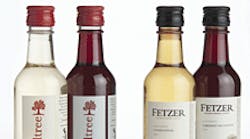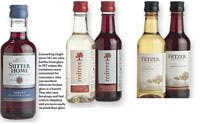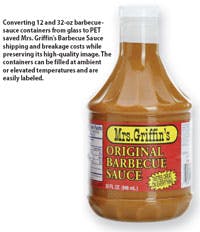Resources: |
Clear plastic bottles are nothing new in food and beverage packaging, but they are now being used in markets where products were traditionally tied to glass. Many companies are choosing bottles made of polyethylene terephthalate (PET) because they are as clear as glass and less likely to break. And customers see the bottles as a greener alternative to glass.
The wine market is one that has been slow to adopt new forms of packaging. Many consumers still believe wine should be packaged in traditional 750‑mL glass bottles with foil-covered corks. Nonetheless, boxed wines and single-serve bottles are becoming more common.
Fetzer, Hopland, Calif., Cecchetti Wine Co., Sonoma, Calif., and Sutter Home, St. Helena, Calif., are among the companies that have converted single-serve 187-mL wine bottles from glass to lightweight PET from Amcor Rigid Plastics, Melbourne, Australia. The bottles preserve the look of the original glass containers and can be run through existing filling lines with minor adjustments.
FDA-approved silicon-oxide coatings developed by KHS Plasmax GmbH, Hamburg, Germany, seal the containers from the inside to keep contents from oxidizing and give PET-bottled wine the same shelf life as wines bottled in glass. The film is less than 100-nm thick and removes easily during recycling.
Eliminating the potential for bottles to break during shipping is a major cost savings. Another advantage is the lighter weight — PET containers weigh 1/6th that of glass bottles with the same volume — which saves transportation costs and cuts fuel consumption.
Sutter holds 38% of the single-serve market, which is expected to amount to 2.2 million cases this year. Fetzer is the tenth largest winery in the U. S. and a leading provider of copacking services. And Cecchetti supplies Redtree wines to Air Canada, British Airways, and Continental Airlines, and is exploring retail distribution of 1-L PET-packaged wines in the Midwest.
Mrs. Griffin’s president and CEO Roland Neel noted a major reduction in freight costs and a significant reduction in broken and damaged-goods charges from retailers. He says PET lets the brand maintain its glasslike appearance for a premium-quality image while improving the packaging’s carbon footprint and recyclability.
The 32-oz decanter-style bottle is the first of its kind to use PET. The 50-gm container can be filled with barbecue sauce that is 140°F. It is also less prone to tipping on the filling line, thanks to a rigid base. A hot-fill version can be filled with liquids up to 185°F.
The 12-oz ring-neck bottle includes a diaphragm in the base that draws upward as the liquid within cools and creates a vacuum. The diaphragm takes the place of side panels other manufacturers use to compensate for vacuum. The panels can make it difficult to smoothly label the bottles. But Amcor’s version can carry a large, uninterrupted label panel around its circumference.


